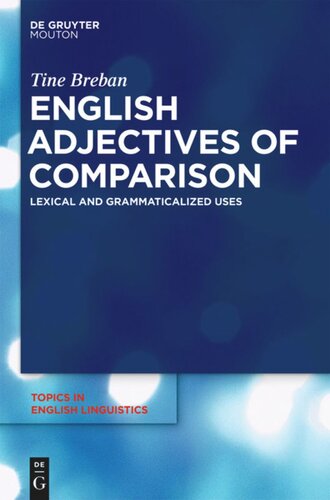

Most ebook files are in PDF format, so you can easily read them using various software such as Foxit Reader or directly on the Google Chrome browser.
Some ebook files are released by publishers in other formats such as .awz, .mobi, .epub, .fb2, etc. You may need to install specific software to read these formats on mobile/PC, such as Calibre.
Please read the tutorial at this link: https://ebookbell.com/faq
We offer FREE conversion to the popular formats you request; however, this may take some time. Therefore, right after payment, please email us, and we will try to provide the service as quickly as possible.
For some exceptional file formats or broken links (if any), please refrain from opening any disputes. Instead, email us first, and we will try to assist within a maximum of 6 hours.
EbookBell Team

4.8
104 reviewsThe book is concerned with a hitherto underresearched grammaticalization process: the development from quality-attributing adjective to determiner in the English noun phrase. It takes a bottom-up approach, based on extensive synchronic and diachronic corpus studies of six English adjectives of comparison: other, different, same, identical, similar and comparable. Their functional diversity in current English is proposed to constitute a case of layering, representing the original descriptive use, which expresses how like/unlike each other entities are, and a range of grammaticalized referential uses, which contribute to the identification and/or quantification of the entities denoted by the NP. Diachronic and comparative data material is invoked to verify and further develop the grammaticalization hypothesis.
The development of adjectives of comparison involves several key concepts identified in the literature. Crucially, it is described as a case of textual intersubjectification driven by the optimalization of recipient-design. The actual grammaticalization paths are diverse and are characterized by lexical as well as structural persistence, i.e. the same lexical meaning develops into different grammatical functions in different syntagmatic configurations.
In order to define the NP as a locus of diachronic change, this study offers a new angle on the description of adjectives and the modelling of NP structure. It advocates the abandonment of the traditional class-based model in favour of a radically functional one, in which functions are defined in terms of prototypicality so as to allow for gradience between and within them. The described grammaticalization processes involve developments from prototypical lexical to grammatical reference-related use within the adjectival category, which can be the starting point of further gradual change to determiners. The traditional relation between classes and positions is envisaged as a correspondence between functional and syntactic zones. The change in form concomitant with grammaticalization in the NP is argued to consist of the reconfiguration of structural combinatorics and progressive leftward movement.
The book is of interest to linguistic researchers and graduate students in linguistics who focus their attention on grammaticalization and subjectification, the functional description of adjectives, questions of deixis and theoretical issues relating to nominal reference.